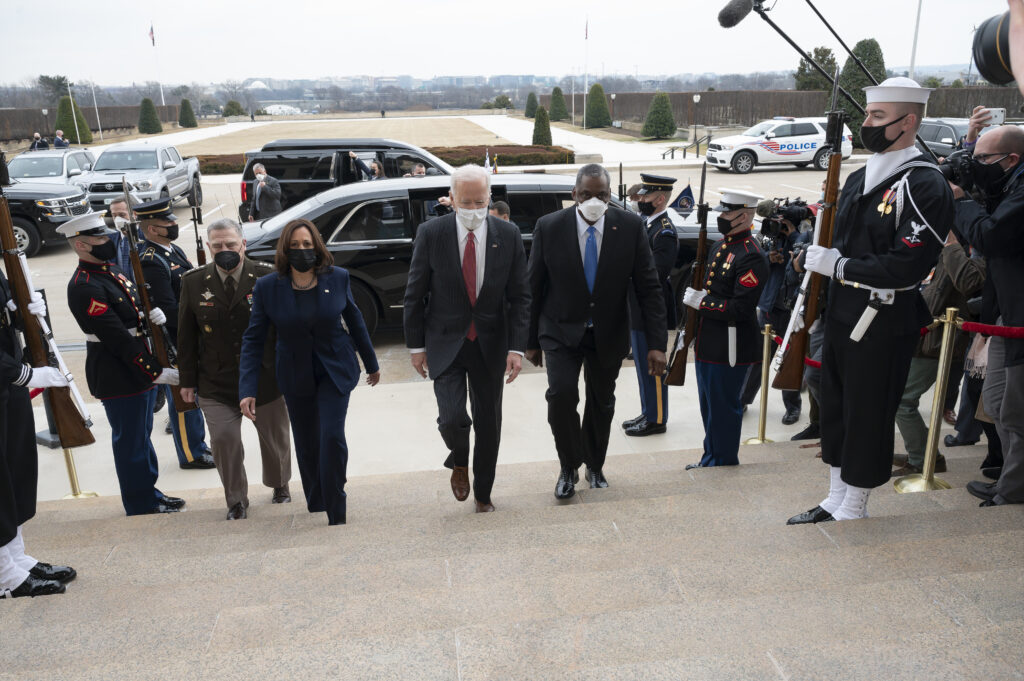
WASHINGTON: Early planning indicates that the Biden administration’s first defense budget might only match last year’s request, marking the second year in a row that the budget request will not keep up with inflation according to several sources familiar with the guidance.
If that planning holds up, the top line for the Pentagon’s 2022 budget will likely come in around the $696 billion the department received in it’s base funding 2021, which was itself just $2.6 billion more than the enacted 2020 budget.
The full budget is now scheduled to be released on May 3. The Biden administration’s first DoD funding request will be delivered to a Congress already split between an emboldened progressive wing of the Democratic party looking to cut defense budgets, and Republicans and conservative Democrats who say spending must rise significantly in order to stay ahead of the Chinese military buildup.
“As far as looking at flat budgets, that’s better than going way up and way down” year over year, said Elaine McCusker, a resident fellow at the American Enterprise Institute and acting DoD comptroller between 2017 and 2020. Massive increases or decreases to the DoD budgets can be actually be destabilizing by throwing off the certainty defense planners need when developing acquisition and sustainment plans that can stretch decades. “So having a flat budget going into ‘22 is not ideal but it’s definitely better than a major shift,” she said.
Mackenzie Eaglen, a defense budget expert at the American Enterprise Institute, said that under the flat budget, “I can foresee both the Navy and Marine Corps cutting the size of F-35B and C squadrons from 16 aircraft to 12 or 10. Could also see the USAF cutting their overall buy of F-35s” in later years, but “with no impact on FY22 production schedules.”
Given likely spending constraints as the Biden administration deals with the massive, $28 trillion national debt and an economy struggling under the effects of COVID 19 shutdowns and rescue packages, the Air Force is “also likely to reduce the number of aircraft in all squadrons — depending on the airframe — justifying further reductions in cargo, tanker, etc.” Eaglen said.
Overall, a flat budget suggests it’s too early for the Biden administration to kick off any deep overhaul of defense spending priorities. Defense Secretary Lloyd Austin has promised reviews of the global force posture, a rewrite of the National Defense Strategy, a deep dive into the Navy’s shipbuilding plan, and a fresh look at nuclear modernization plans, all of which aren’t expected to be complete for months, if not a year or more.
What the flat budget will do, however, is cut a starkly different path for Pentagon spending than the draft $722 billion 2022 defense budget the Trump administration released in December, a number that will undoubtedly be tossed around in hearings on the Hill.
The first budget in any administration is by necessity the result of just a few months of work as the new team finds its footing. One of the biggest drags on defense planning for any new administration is the absence of service secretaries. Without Senate-approved political leadership the services rarely proffer budgets that are much beyond placeholders. No Biden service secretaries have been nominated yet.
The flat top line could also mean that “inertia will prevail,” since on Capitol Hill, “neither the progressives nor GOP has adequate pull to win, or even draw much to their side, so we’re likely to settle in close to where we are now,”or about $740 billion once nuclear costs are factored in, said Christopher Preble, co-director of the New American Engagement Initiative at the Atlantic Council.
“You can’t obtain serious and durable cuts in Pentagon spending without an equally serious rethinking of our strategic objectives,” Preble added. “Resources constraints should cause us to rethink our strategic objectives, but the Biden team seems unwilling to do that.”
The Trump administration’s lame duck budget proposal for 2022 however, would have made large increases to the Navy’s shipbuilding accounts while eliminating the entire Overseas Contingency Operations account and trimming 1,300 soldiers from the Army’s ranks.
There is little chance the Biden administration will follow through on all of those plans, though early signals from Defense Secretary Lloyd Austin and Deputy Secretary Kathleen Hicks indicate that new ships and modernizing shipyards are likely to take precedence over things like Army end-strength and retaining Cold War-era platforms. Several prominent lawmakers, as well as the Chairman of the Joint Chiefs of Staff, say the Navy must receive a larger slice of the budget in coming years.
The Navy is likely to take a hard look at retiring its aging cruisers, continue pushing plans to retire the first four Littoral Combat Ships, as well as possibly its oldest destroyers. The Army will likely eyeball its oldest Apache and Chinook helicopters, and potentially reduce the size of the force.
Navy CNO Adm. Mike Gilday told Breaking Defense recently his staff is using the published 2022 numbers as a guideline for working with the new administration on the budget.
“What we’re doing is presenting the approach that we had under the previous administration that produced DoD’s budget submission a few months ago,” he said, while prioritizing new ship classes and investing in hypersonics and precision weapons.
Chief among the subjects for review is the roughly $167 billion the draft budget called to be pumped into the Navy’s account over the next five years, starting with a $27 billion shipbuilding budget in 2022, a huge increase from the $19 billion requested in 2021. That account would balloon to $33 billion by 2026.
Congress will also have a shot at the Biden plan, and lawmakers have traditionally been loath to cut any program which produces jobs in their districts. But it is unclear what programs they will eventually vote to save, and at what cost.
There will be trades made within the budget however that will have some significant impacts across the DoD,
By failing to keep up with inflation, the Pentagon will need to find other places to find money to fund annual pay raises, health care, and goods and services, said Thomas Spoehr, a retired Army lieutenant general who directs the Heritage Foundation’s Center for National Defense. “With a flat budget DoD would have to find $15 billion of savings in other programs — at the same time they are endeavoring to fund a robust Navy to counter China and to refurbish our aging nuclear deterrent,” he said.

